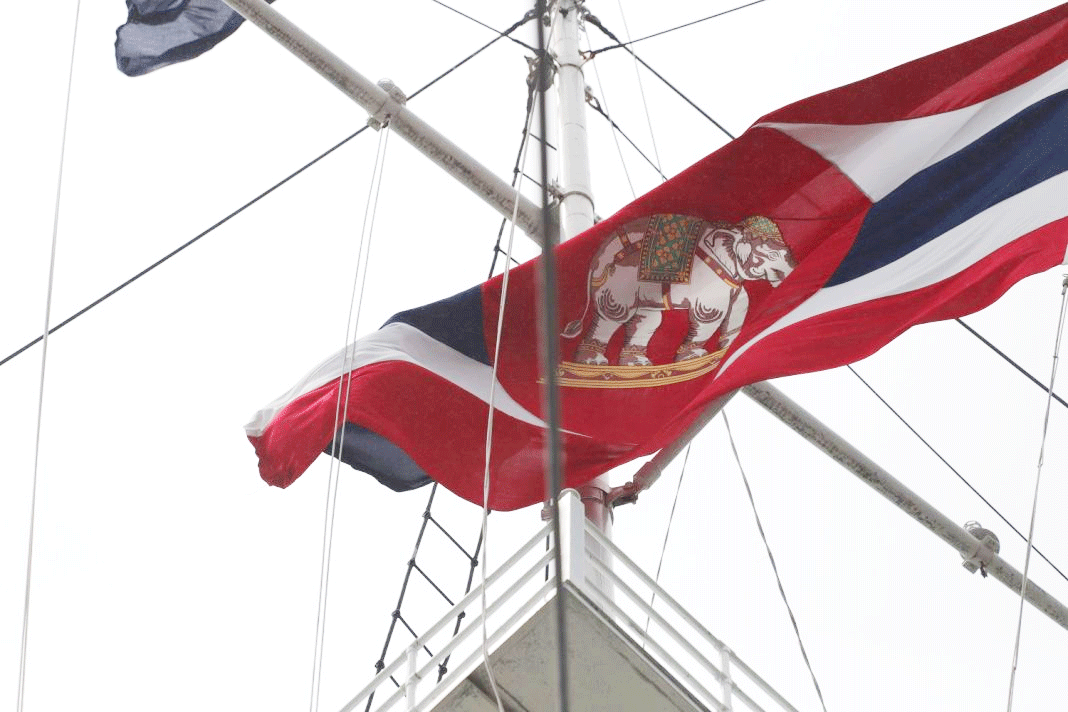Top: A Royal Thai Navy flag flies over Wichai Prasit Fort in Bangkok.
This Saturday 67 years ago, the river that for centuries has been a lifeline for Bangkok turned red with blood.
Instead of the familiar scenery of glittering palaces and serene temples, imagine a scene of battle. The flagship of the Royal Thai Navy anchors in the river, a battered fortress under assault from air force bombers and army troops who rake it with fire from the bullet-ridden embankment.
Dark plumes of smoke choke the sky from bombing runs on the navy’s bases and fuel stores. In place of the usual boats and ferries are burning metal flotsam, a sheen of oil, spent ammunition cartridges and the human cost of a failed revolt.
“The sound of gunfire and explosions. The flames. The smoke. The bright red color of blood,” one navy seaman who survived the battle later recalled in a memoir.
“The distorted faces that show the sheer agony of the wounded,” he wrote. “The mangled strips of flesh mixed with blood and pieces of bones. The pale, bloated faces of corpses left in abandoned corners. Some still wore the uniform of the Royal Navy.”
It was June 30, 1951. Just a day prior, a group of naval officers mutinied aboard the Manhattan, a US-donated dredging ship, and took the prime minister hostage in an attempt to overthrow the ruling junta. After heavy fighting, the coup fell apart less than 24 hours later, but its implications – from a realignment of the armed forces to future democratic fortunes – echo to this day.
Because of the short-lived mutiny, the navy – once a proud rival of the army – was disarmed and sidelined in the halls of power. Its fleet of Mitsubishi-built submarines were decommissioned and sold for scrap.
Most significantly for the nation, the Manhattan Rebellion marked defeat for progressive elements within the navy who had struggled against army oligarchs since the birth of Thai democracy.
“What’s interesting is that it was the first and only coup launched by navy officers,” Surachart Bumrungsuk, an expert on the Thai armed forces, said from his office just down the road from where navy troops and soldiers skirmished 67 years ago. “And this history is a history that younger people may not know about.”
Coups are nothing special in Thai history. More than 10 have succeeded while another dozen have failed. But the events that unfolded for two days in June 1951 – which later became known as the Manhattan Rebellion for the vessel where the plot played out – surpassed many terms of devastation and political consequences.
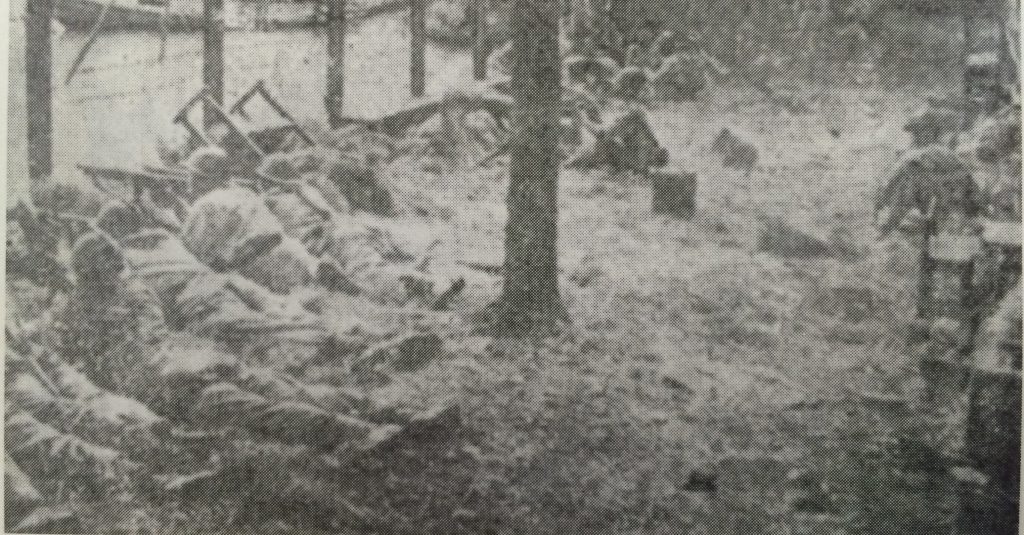
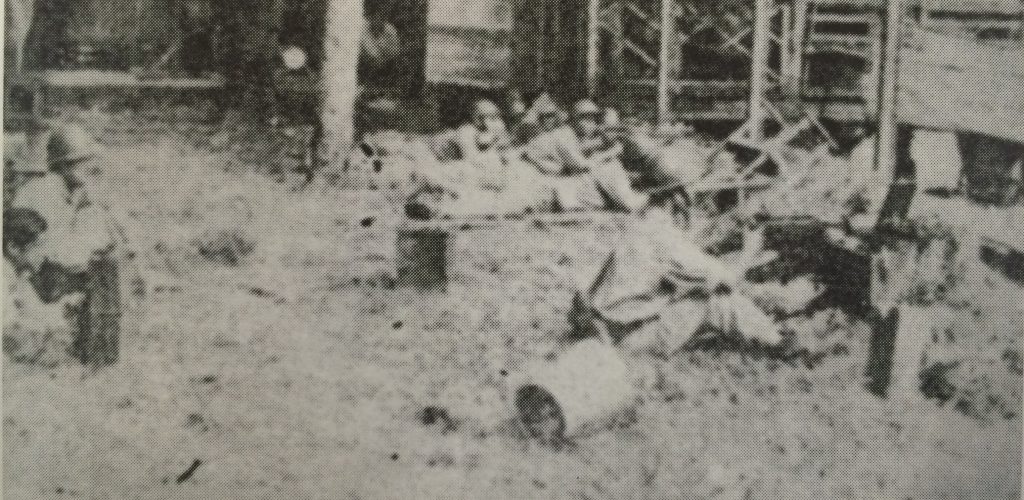
While many coups have been bloodless, beginning and ending with a clique of army men reading their communique over the airwaves, the revolt in 1951 turned parts of Bangkok into a battlefield.
Navy riflemen battled columns of armored vehicles and troops next to the British Embassy, where CentralEmbassy stands today, before they were pushed back to make a stand near Lumphini Park. Marines fought the police and army in Thonburi and along the river. Even the city pillar shrine was struck by a navy shell. By the end of it, about 600 people were killed or wounded, most of them civilians caught in the crossfire.
For the key plotters, the uprising was more than a power struggle. They saw themselves as the salvation for democracy and transparency in a country ruled by army autocrats who four years earlier had ousted a democratically elected government.
“Many of the coup-makers got noticeably richer, yet the people kept getting poorer,” Lt. Cmdr. Manat Charupha, a leader of the Manhattan coup, wrote in his memoirs. “The way Thailand was ruled back then was only a democracy in name. In reality, it should have been called an oligarchy.”
Disavowed by History
To revisit one of Thailand’s bloodiest slices of history, I assumed the Navy Museum in southeast Bangkok would be the best place to start.
Located just a stone’s throw from the naval academy – an hour’s drive or more from inner Bangkok – the sparsely attended facility is more navy memorabilia storehouse than museum. The curator admitted that much during a recent visit; he wants it moved to a navy property just opposite the Grand Palace by 2022.
Its collection covers the force’s extensive history, from a 1941 battle with French forces to the recent purchase of three Chinese submarines. But no mention could be found of the dramatic showdown in the Chao Phraya 67 years ago.
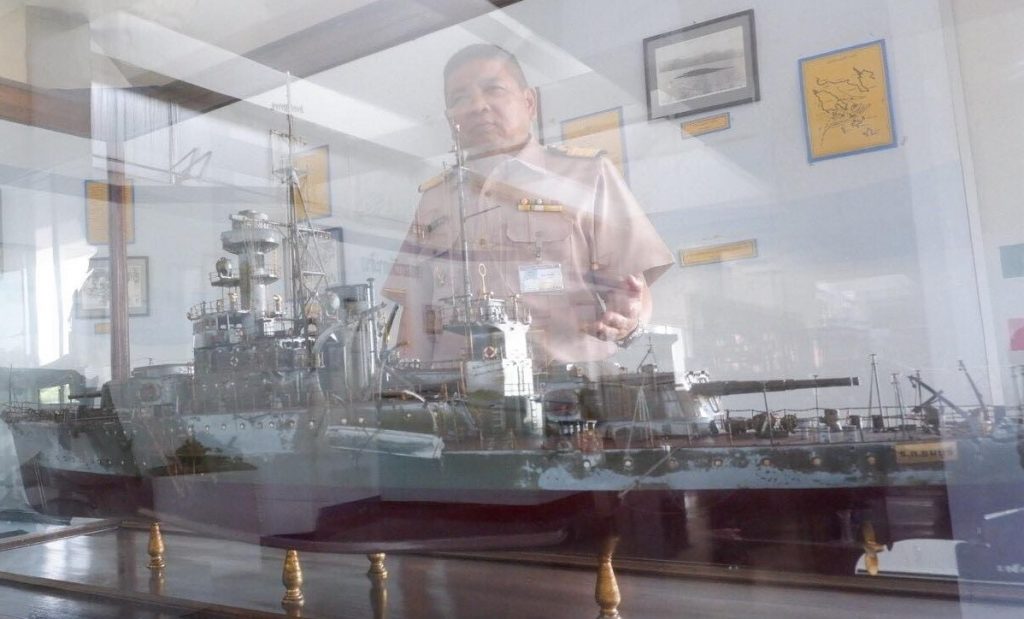
“No, we don’t have anything about Manhattan over here,” Capt. Chatchai Sukrasorn, the curator and chief naval historian, said when asked about the failed revolt.
Why not? Chatchai said being included in the Royal Thai Navy’s history was only for the honorable.
“We only honor those who follow orders,” said the historian who served a tour in the restive Deep South. “It was only a matter that involved a group of individuals. It was just one group. The Royal Navy had no part in it.”
The historian also took offense at the notion the rebellion involved conflict between the army and the navy.
“Last time someone came here to talk to me about Manhattan, they distorted history to make it sound like the army and the navy didn’t like each other,” fumed Chatchai, who said he enlisted 30 years ago “to see the world.”
While they may be written off as a few bad apples, the coup-makers enjoyed broad support and sympathy from their fellow seamen, at least according to the man who led the bloody putsch.
“Our group, which consists of many young officers, often met to talk and discuss all the disgraceful behavior of the government at the time,” Manat wrote in his memoir. “We wanted to take decisive action once and for all, because we believed in our unity and solidarity.”
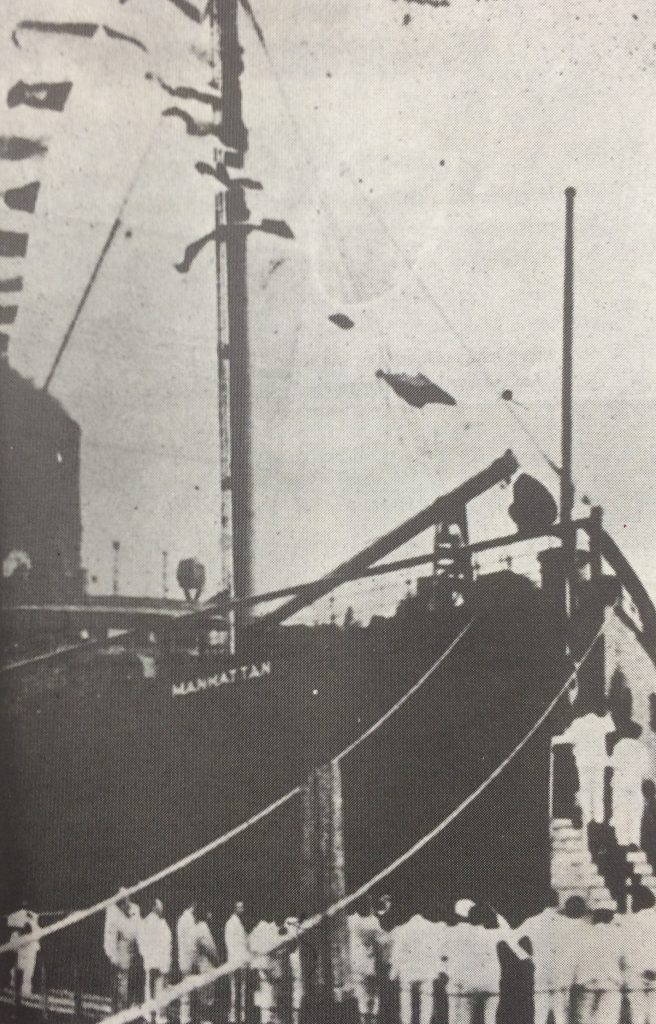
Many in the navy had cause to be frustrated, historian Thamrongsak Petchlertanan said. The corps were created by King Rama V to modernize Siam and save it from maritime Western colonizers.
“The navy had a quality that’s different from the army. They are more receptive to the world,” said Thamrongsak, who has written a number of books on Thai political history. “They had to train in sailing across the seas to many countries. This is a factor that made them see the world and learn about reality in other countries.”
This, Thamrongsak said, also led to another shared trait: a tendency to support democratic values. When a group of military officers overthrew the absolute monarchy in 1932, it included 30 army officers and 25 from the navy.
But the army strongmen, aided by the conservative elite, soon consolidated power in their own clique through coups and purges, gradually sidelining the navy, said Surachart, the military expert who teaches at Chulalongkorn University.
By 1951, power appeared to be in the hands of three men: Prime Minister Plaek Pibulsongkram – the infamous fascist copycat who ruled wartime Thailand, Field Marshal Phin Choonhavan and an up-and-coming army lieutenant general named Sarit Thanarat.
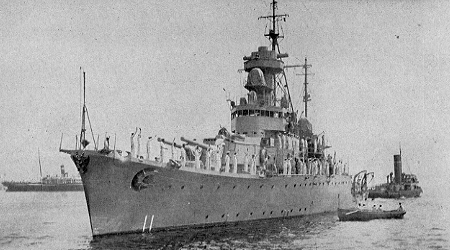
“There was conflict between the navy and army hidden beneath the surface,” Surachart said. “The navy felt that after the army assumed leadership, they neglected to improve the navy. All the key positions were taken by the army.”
The fleets needed repairs. Pre-war submarines were in dire need of replacement. Training was underfunded. According to historical anecdote, an officer remarked bitterly to a class of cadets that the navy had become the world’s largest ship museum.
Amid a stack of grievances and aspirations to change the nation’s direction, the stage was set for the navy’s Young Turks to act.
‘Man Your Battle Stations!’
The small, quiet pier at Wat Rachathiwat juts into the river. Rafts of water hyacinth bob gently whenever the express boats sail past. The only visitors are local students who feed bread to the fish. It’s hard to imagine the busy roads of Bangkok are just a couple hundred meters away.
But in 1951, it was home to the navy’s river armada. Among the war ships assembled here was the Japanese-built Sri Ayudhya, a coastal defense ship armed with six turrets, which include pair of guns that could strike a target 29 kilometers away. She was the largest ship in active duty; her sister ship, the Thonburi, was knocked out of service following a duel with French gunboats in 1941.
At the time, before the navy would be banished out to Sattahip, Bangkok was its home as much as the army’s. The former royal palace on the Thonburi side doubled as headquarters. A navy dockyard was close by. The fleet battle group command occupied the Ratchaworadit Pier facility just outside the Grand Palace. The Navy Signal Corps sat on what would later become the Suan Lum Night Bazaar while its elite-force marines were based close to Siriraj Hospital.
Interactive timeline on an authentic 1945 map of Bangkok
Calling themselves the “Save the Nation Group,” the ringleaders spent months courting the commanders of these combat units to join their plot to overthrow the government and restore democratic rule.
On the way to the deck of the Manhattan, they made a series of blunders. Operations were repeatedly called off at the last minute, including a plot to kidnap Plaek a year earlier at Khlong Toei Port as he bid farewell to troops headed for the Korean War. Disheartened by the failure, some conspirators withdrew, including an army infantry commander.
By June 1951, the entire navy heard rumors of a coup in the making, Lt. Cmdr. Manat noted in his memoir. Thamrongsak the historian believed the admirals were definitely aware of the plot but chose not to report it to the government.
“The fact that these young soldiers could move their forces around means that the top leaders must have known about it, but they pretended not to see anything,” Thamrongsak said. “I think deep down in their hearts, they were sympathetic.”
Their day of action finally came on June 29, 1951. Plaek was at a ceremony to receive a dredging vessel donated by the US government for service in the Chao Phraya River delta. The ship, named Manhattan, was moored at Ratchaworadit Pier.
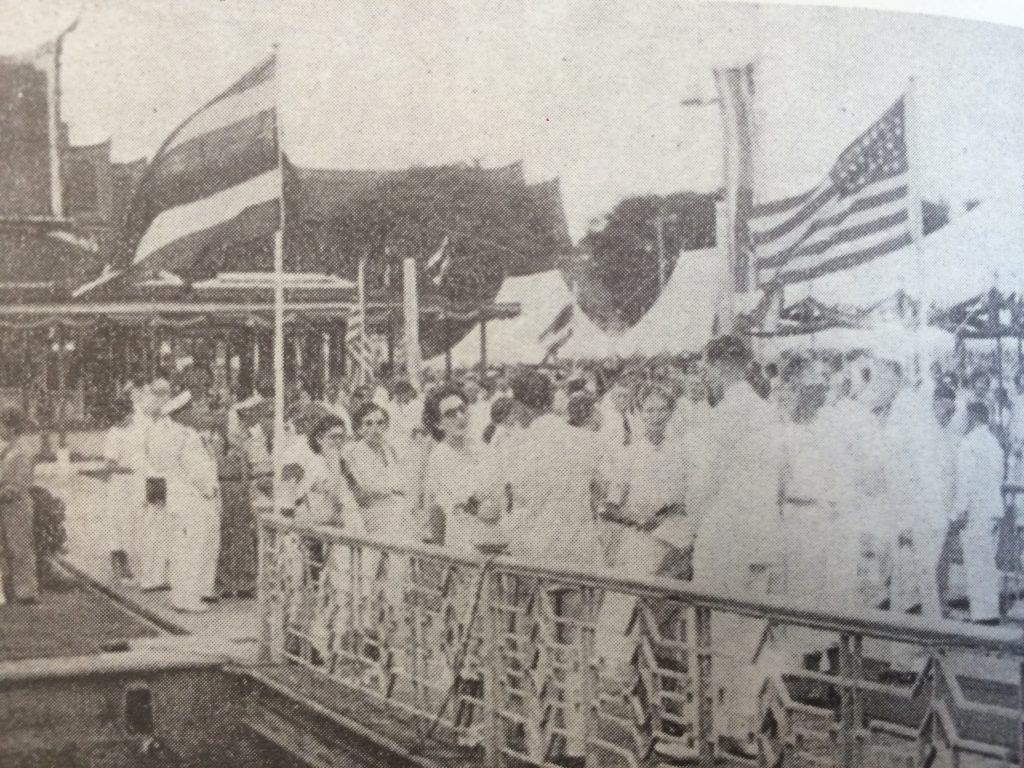
The big moment came at 3:30pm.
That’s when a combat squad led by Manat himself crashed the ceremony and captured Plaek while he was speaking on the Manhattan’s deck. At gunpoint, he’s taken via a landing boat to the Sri Ayudhya, which now flies the rebel flag. Almost simultaneously, naval forces loyal to the plotters seize key intersections and government buildings. The coup has begun.
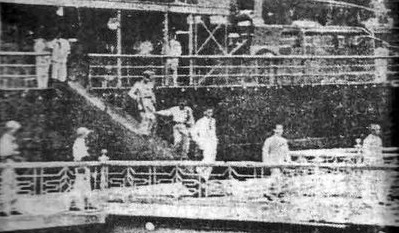
“The sound of bugle calls pierced through the air, rousing the nerve of every man on the ship,” Niyom Sukrongpaeng, a sergeant who joined the revolt, wrote in his account. “It was followed by the most profound command for all navy seamen: Man your battle stations!”
With the prime minister now a hostage in her cabin, the Sri Ayudhya leaves Wat Rachathiwat, heading for a supply base to the southeast in what is now the Bang Na suburb. There the coup-makers will demand the regime’s surrender. If it refuses, the rebels will form a provisional government in Songkhla while a larger naval force from Chonburi attacks the capital.
But the plan soon hits a dead-end. Two marine battalions who were supposed to capture the Rama I Bridge and raise it for the rebel flagship to pass never show up; their commanders have decided to side with the government. Sri Ayudhya is trapped.
Yet the rebels persist. Navy troops and marines fight the army and police. Government forces trying to capture the Signal Corps are pinned down in the roads around Lumphini Park. A similar operation to retake Ratchaworadit Pier is met with fierce resistance. The Rama I Bridge becomes a no man’s land, with each end held by opposing forces.
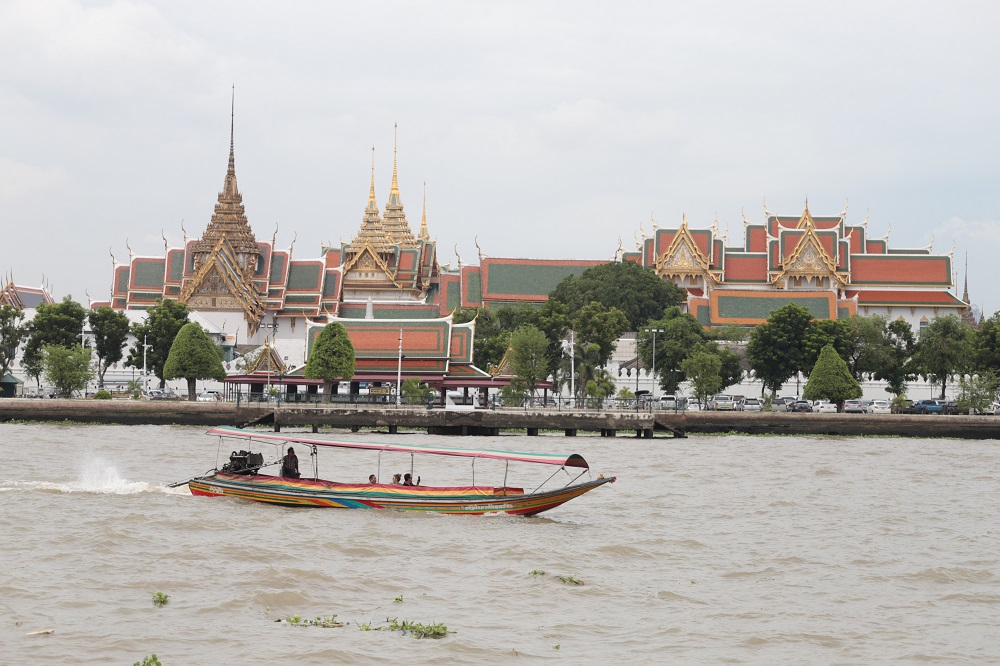

By nightfall, it’s clear the rebels are hopelessly outnumbered. Many ships and units refuse to join the rebellion. True to military code, they will only move out if the top navy commander, Admiral Sindhu Kamolnawin, gives the order. But Sindhu and other key leaders are silent. History would say they didn’t want to get involved. The order never came.
Over public airwaves, the junta instructs the insurgents to stand down and return Plaek safely. Ominously, it also urges the prime minister to “prepare to sacrifice for the good of the country.” The statement is followed by a message from the air force threatening to let its bombs fall. It warns civilians to stay clear of the mutineers.
“Worry about yourselves! Do not worry about the rebels who are about to meet their doom!” went the message. “The air force considers this the last warning to the rebels. Surrender now.”
The coup leaders took it as a bluff. Surely it was impossible that the junta would endanger its prime minister in an attack? This is where the rebels made their mistake, said Thamrongsak. Unbeknown to the young mutineers, Plaek no longer held the same influence.
“They thought they could win by arresting Field Marshal Plaek, because they thought he was a valuable person. He was both prime minister and defense minister,” the historian said. “He looked important, but in fact every other commander was willing to sacrifice him. The leader who seemed to have absolute power in his hands was in fact very fragile.”
Battle For the Capital
When dawn breaks, Bangkok awoke to a crescendo of war. The army and police, whose advance was stalled the first day, remount a coordinated assault across the city on rebel positions. Using the Flower Market and Rajini School as cover, government forces rain mortar shells and gunfire on the Sri Ayudhya. Plaek would later write that one shell landed on his bed, narrowly missing him.

Then came the warplanes, slamming their 50-kilogram bombs into the Sri Ayudhya. Within moments, naval bases along the river are under heavy bombardment, sending the defenders scrambling for cover. Huge blazes broke out at the fuel depots. Some pilots, blinded by the smoke, miss their targets and drop their bombs on civilian areas instead.
One by one, the rebel defenses collapse throughout the day. The Rama I Bridge and Ratchaworadit Pier are captured, forcing rebel troops to join their comrades at naval headquarters on the western bank, which soon comes under relentless assault from forces loyal to the government.
By 3:40pm, the Sri Ayudhya can take no more. A fire breaks out and the vessel begins to list. There’s no option but to abandon ship. Sgt. Niyom, who was fighting nearby on the river bank, later described its final moments:
“I felt like something was stuck in my throat. The ship crewmen gathered around a ladder, their faces turned to the stern. They saluted, in seaman tradition, one last time. The Royal Navy flag was still flying on the gaff amid the smoke and flames. The ship was sinking, but the flag wouldn’t come down.”
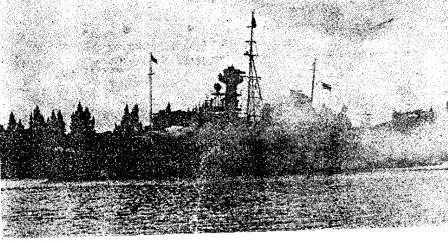
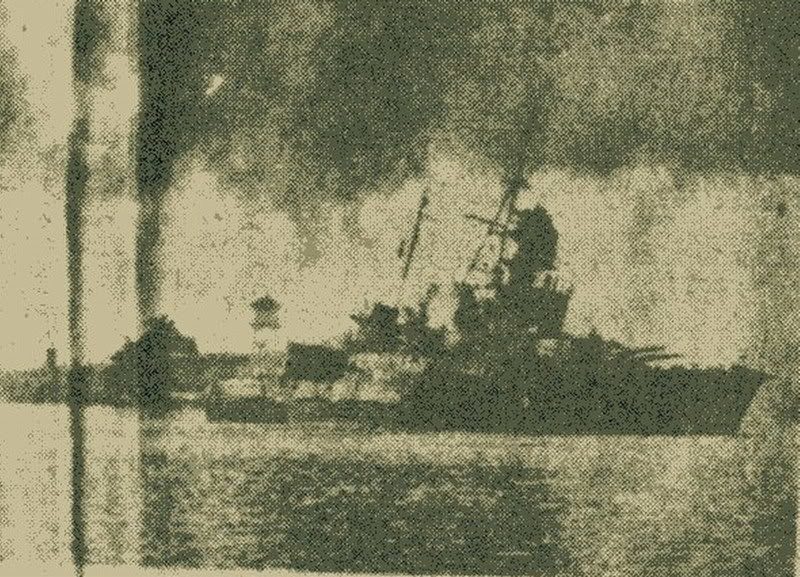
Plaek is given a lifevest and told to swim for his life like everyone else. Army machine gun fire chases them as they swim to the shore. Some sailors die, but the prime minister emerges from the water miraculously unscathed.
As night returns, the rebellion disintegrates. Manat and other ringleaders make their way to a railway station and escape to the north. Plaek is brought to the government command center by naval representatives seeking ceasefire. They are promptly arrested. Sri Ayudhya is left foundering and burning until she sinks a day later.
Naval bases are captured. Small pockets of rebellion hold out and continue fighting through the night, but their resistance dissipates on the next day. By the afternoon of July 1, 1951, the Manhattan Rebellion came to an ignominious end.
Official records say about 200 people were killed, about half of them civilians. Up to 600 people were injured.
A Vanquished Navy
At the western end of Khaosan Road hangs a bell that likely escapes attention from the millions of backpackers and revelers that pass it. “Impregnable,” proclaims an inscription on the brass bell, which is enshrined on an altar in front of the Chanasongkram Police Station.
A plaque would explain to any passerby that it was salvaged from the Manhattan, the donated dredger that unwittingly became the stage where fate of the nation was decided few kilometers away. It’s probably the only public memorial to that rebellion 67 years ago.
Even before the smoke cleared over Bangkok, the government moved on the navy, convinced it had allowed the Manhattan plot to fester beneath its hull.
“One important consequence was the purging of the navy,” Thamrongsak said.

The entire navy leadership was immediately fired, including Admiral Sindhu, its top commander. Seventy more officers were relieved of duty in the following days. Then came the arrests of more than 1,300 seamen suspected of joining or aiding the rebellion. The number was so large that the National Stadium was used to hold them.
The naval command structure was redrawn and its maw wired shut.
Battle groups were abolished. All combat aircraft were handed over to the Air Force. Heavy weapons were confiscated. Naval bases in Bangkok were relocated to outer provinces such as Chonburi and Samut Prakan. The marine force was downsized and placed under wartime army command. In a sting that would be felt for generations, its submarine fleet was decommissioned.
When the dismantling was completed, the navy was reduced to being more of a coast guard than a force of war.
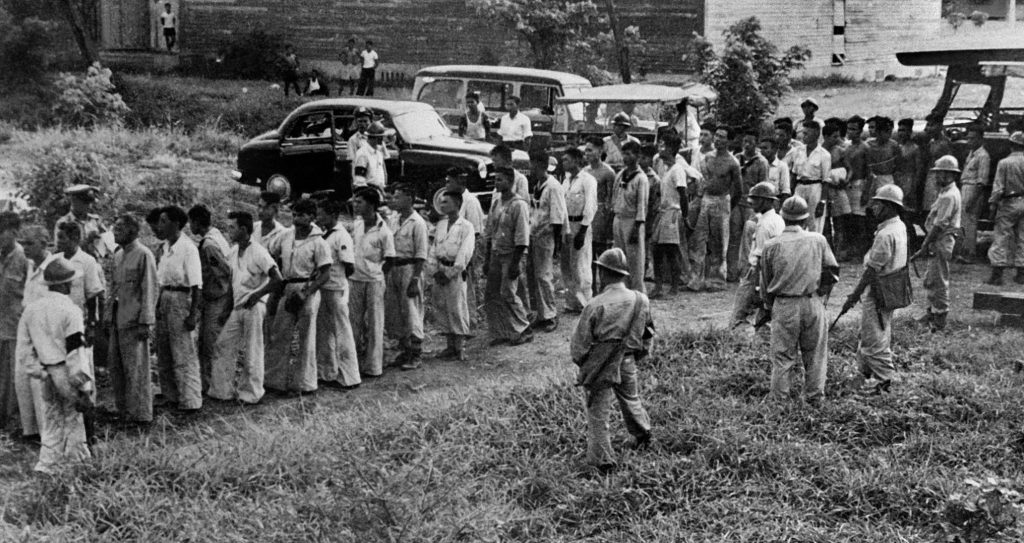
Capt. Chatchai, the navy historian, refused to describe the literal dressing down as revenge. Bangkok and the mighty Chao Phraya were becoming too crowded for naval ships and troops anyway, so a move out of the capital made sense, he said.
As for the subs, Chatchai said they were scuttled because they were simply too old, and the government could not afford a new fleet. He also defended the decimation of the officer’s corps, citing military doctrine that holds commanders accountable for the misconduct of their underlings.
“If Khaosod English gets caught selling sensitive information to The Nation, wouldn’t Khaosod punish your editorial team, too?” the captain asked.
Surachart, the Chulalongkorn professor, said the Manhattan revolt also cut the navy off from its share in power and opened the way for other players – namely, rising army star Sarit Thanarat, who several years later would seize power from Plaek and plunge Thailand into a decade of direct military rule.

“The navy was in a frozen state, and they lost their political role,” he said. “Their military role was also reduced. It was destroyed in the Manhattan incident.”
Civil society, too, was choked off along with the navy’s thirst for democracy, historian Thamrongsak said. It was no coincidence, he noted, that the Manhattan Rebellion was followed by another coup, which came with mass arrests of intellectuals and censorship of the media. The junta was confident the navy could not pose any threat to its suppression.
“There was no one left who could defy the army,” Thamrongsak said.
Happily Ever After?
Sixty-seven years on, it is hard to imagine the military as divided as they were when the Manhattan Rebellion.
Gen. Prayuth Chan-ocha, the current junta leader, is reputed to have united the armed forces through his dispensing of rewards and key positions. His regime even gave a submarine fleet back to the navy after more than six decades of waiting.
The navy never rose up again after the bloodshed of 1951, and the force is no longer synonymous with progressive values. The idealistic fire that once burned in the hearts of many young naval officers was put out long ago, Surachart suggested.
“I think the conflict was over long ago,” the military expert said.
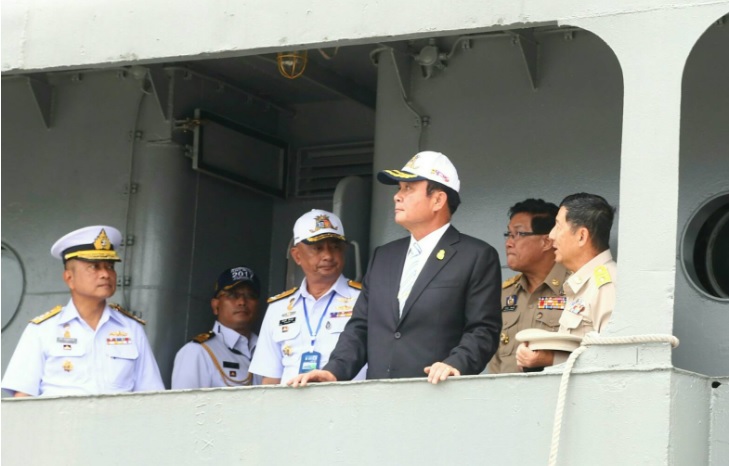
He continued, “The leaders of the Thai navy have not gone through the events like 1932 and the Second World War. They don’t exist anymore. New ideas aren’t being born anymore. The conflict we’re talking about has dissipated along with the time. It’s now just a history.”
For Chatchai, having no feud within the military could only be a good thing.
“It is very important to have a unified command,” Chatchai said. “No military branch could fight on its own.”
Somewhere in the Navy Museum, a sailor rings a bell five times – a naval way of saying it’s 2:30pm, Chatchai explained. At the end of our discussion on the turbulent event that brought so much destruction and disgrace to the navy 67 years ago, he offered somewhat sympathetic parting words for Manat and his band of mutineers.
“They were young men caught up in their dreams for a utopia. I understand they were trying to fight for something better,” the captain said. “But they chose the wrong way to do it.”


































